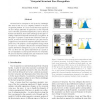102
click to vote
CVPR
2011
IEEE
14 years 4 months ago
2011
IEEE
Compressive Sensing has become one of the standard methods of face recognition within the literature. We show, however, that the sparsity assumption which underpins much of this w...
MVA
1990
14 years 9 months ago
1990
We have developed a near-real-time computer system which can locate and track a subject's head, and then recognize the person by comparing characteristics of the face to thos...
ICB
2009
Springer
15 years 23 days ago
2009
Springer
In this paper, we propose a random network ensemble for face recognition problem, particularly for images with a large appearance variation and with a limited number of training se...
CVPR
2010
IEEE
15 years 1 months ago
2010
IEEE
In this paper, a new scheme to address the face recognition problem is proposed. Different from traditional face recognition approaches which represent each facial image by a sing...
AVBPA
2003
Springer
15 years 1 months ago
2003
Springer
This paper describes a novel framework for the Open World face recognition problem, where one has to provide for the Reject option. Based upon algorithmic randomness and transducti...
ECCV
2006
Springer
15 years 10 months ago
2006
Springer
Recently, the wide deployment of practical face recognition systems gives rise to the emergence of the inter-modality face recognition problem. In this problem, the face images in ...
ICCV
2001
IEEE
15 years 10 months ago
2001
IEEE
We develop a pairwise classification framework for face recognition, in which a class face recognition problem is divided into a set of ? ?? ? two class problems. Such a problem...
CVPR
2008
IEEE
15 years 10 months ago
2008
IEEE
Variation due to viewpoint is one of the key challenges that stand in the way of a complete solution to the face recognition problem. It is easy to note that local regions of the ...
CVPR
1998
IEEE
15 years 10 months ago
1998
IEEE
We introduce in this paper two probabilistic reasoning models (PRM-1 and PRM-2) which combine the Principal Component Analysis (PCA) technique and the Bayes classifier and show th...


